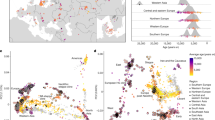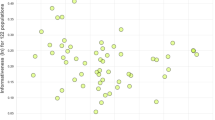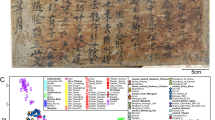Abstract
Northwest China is closely adjacent to Central Asia, an intermediate region of the Eurasian continent. Moreover, the Silk Road through the northwest of China once had a vital role in the east–west intercommunications. Nevertheless, little has been known about the genetic makeup of populations in this region. We collected 503 male samples from 14 ethnic groups in the northwest of China, and surveyed 29 Y-chromosomal biallelic markers and 8 short tandem repeats (STRs) loci to reconstruct the paternal architecture. Our results illustrated obvious genetic difference among these ethnic groups, and in general their genetic background is more similar with Central Asians than with East Asians. The ancestors of present northwestern populations were the admixture of early East Asians peopling northwestward and later Central Asians immigrating eastward. This population mixture was dated to occur within the past 10 000 years. The J2-M172 lineages likely entered China during the eastward migration of Central Asians. The influence from West Eurasia through gene flows on the extant ethnic groups in Northwest China was relatively weak.
Similar content being viewed by others
Log in or create a free account to read this content
Gain free access to this article, as well as selected content from this journal and more on nature.com
or
References
Jin, L. & Su, B. Natives or immigrants: modern human origin in East Asia. Nat. Rev. Genet. 1, 126–133 (2000).
Underhill, P. A., Passarino, G., Lin, A. A., Shen, P., Mirazón, L. M., Foley, R. A. et al. The phylogeography of Y chromosome binary haplotypes and the origins of modern human populations. Ann. Hum. Genet. 65, 43–62 (2001).
Underhill, P. A., Shen, P., Lin, A. A., Jin, L., Passarino, G., Yang, W. H. et al. Y chromosome sequence variation and the history of human populations. Nat. Genet. 26, 358–361 (2000).
Jobling, M. A. & Tyler-Smith, C. The human Y chromosome: an evolutionary marker comes of age. Nat. Rev. Genet. 4, 598–612 (2003).
Karafet, T. M., Mendez, F. L., Meilerman, M. B., Underhill, P. A., Zegura, S. L. & Hammer, M. F. New binary polymorphisms reshape and increase resolution of the human Y chromosomal haplogroup tree. Genome. Res. 18, 830–838 (2008).
de Knijff, P. Messages through bottlenecks: on the combined use of slow and fast evolving polymorphic markers on the human Y chromosome. Am. J. Hum. Genet. 7, 1055–1061 (2000).
Wells, R. S., Yuldasheva, N., Ruzibakiev, R., Underhill, P. A., Evseeva, I., Blue-Smith, J. et al. The Eurasian heartland: a continental perspective on Y-chromosome diversity. Proc. Natl Acad. Sci. USA 98, 10244–10249 (2001).
Zerjal, T., Wells, R. S., Yuldasheva, N., Ruzibakiev, R. & Tyler-Smith, C. genetic landscape reshaped by recent events: Y-chromosomal insights into Central Asia. Am. J. Hum. Genet. 71, 466–482 (2002).
Comas, D., Plaza, S., Wells, R. S., Yuldaseva, N., Lao, O., Calafell, F. et al. Admixture, migrations, and dispersals in Central Asia: evidence from maternal DNA lineages. Eur. J. Hum. Genet. 12, 495–504 (2004).
Quintana-Murci, L., Chaix, R., Wells, R. S., Behar, D. M., Sayar, H., Scozzari, R. et al. Where west meets east: the complex mtDNA landscape of the southwest and Central Asian corridor. Am. J. Hum. Genet. 74, 827–845 (2004).
Yao, Y. G., Kong, Q. P., Wang, C. Y., Zhu, C. L. & Zhang, Y. P. Different matrilineal contributions to genetic structure of ethnic groups in the Silk Road region in china. Mol. Biol. Evol. 21, 2265–2280 (2004).
Du, R. & Yip, V. F. Ethnic Groups in China (Science Press, Beijing and New York,, 1993).
Sun, K. The Research in Culture Changes of the Peoples Speaking Turkic Languages Ningxia People's Publishing House, 2004, Yinchuan.
Cinnioğlu, C., King, R., Kivisild, T., Kalfoğlu, E., Atasoy, S., Cavalleri, G. I. et al. Excavating Y-chromosome haplotype strata in Anatolia. Hum. Genet. 114, 127–148 (2004).
Y Chromosome Consortium. A nomenclature system for the tree of human Y-chromosomal binary haplogroups. Genome. Res. 12, 339–348 (2002).
Kayser, M., Roewer, L., Hedman, M., Henke, L., Henke, J., Brauer, S. et al. Characteristics and frequency of germline mutations at microsatellite loci from the human Y chromosome, as revealed by direct observation in father/son pairs. Am. J. Hum. Genet. 66, 1580–1588 (2000).
Excoffier, L., Laval, L. G. & Schneider, S. Arlequin ver. 3.0: an integrated software package for population genetics data analysis. Evol. Bioinformatics Online 1, 47–50 (2005).
Excoffier, L., Smouse, P. E. & Quattro, J. M. Analysis of molecular variance inferred from metric distances among DNA haplotypes: application to human mitochondrial DNA restriction data. Genetics 131, 479–491 (1992).
Xue, Y., Zerjal, T., Bao, W., Zhu, S., Shu, Q., Xu, J. et al. Male demography in East Asia: a north-south contrast in human population expansion times. Genetics 172, 2431–2439 (2006).
Gayden, T., Cadenas, A. M., Regueiro, M., Singh, N. B., Zhivotovsky, L. A., Underhill, P. A. et al. The Himalayas as a directional barrier to gene flow. Am. J. Hum. Genet. 80, 884–894 (2006).
Bandelt, H. J., Forster, P. & Röhl, A. Median-joining networks for inferring intraspecific phylogenies. Mol. Biol. Evol. 16, 37–48 (1999).
Derenko, M., Malyarchuk, B., Denisova, G. A., Wozniak, M., Dambueva, I., Dorzhu, C. et al. Contrasting Patterns of Y-chromosome variation in South Siberian populations from Baikal and Altai-Sayan regions. Hum. Genet. 118, 591–604 (2006).
Semino, O., Magri, C., Benuzzi, G., Lin, A. A., Al-Zahery, N., Battaglia, V. et al. Origin, diffusion, and differentiation of Y-chromosome haplogroups E and J: inferences on the neolithization of Europe and later migratory events in the Mediterranean area. Am. J. Hum. Genet. 74, 1023–1034 (2004).
Di Rienzo, A., Peterson, A. C., Garza, J. C., Valdes, A. M., Slatkin, M. & Freimer, N. B. Mutational processes of simple-sequence repeat loci in human populations. Proc. Natl Acad. Sci. USA 91, 3166–3170 (1994).
Kittles, R. A., Perola, M., Peltonen, L., Bergen, A. W., Aragon, R. A., Virkkunen, M. et al. Dual origins of Finns revealed by Y chromosome haplotype variation. Am. J. Hum. Genet. 62, 1171–1179 (1998).
Wilson, I., Weale, M. & Balding, D. Inferences from DNA data: population histories, evolutionary processes and forensic match probabilities. J. R. Stat. Soc.: Ser. A Stat. Soc. 166, 158–188 (2003).
Zhivotovsky, L. A. Estimating divergence time with the use of microsatellite genetic distances: impacts of population growth and gene flow. Mol. Biol. Evol. 18, 700–709 (2001).
Zhivotovsky, L. A., Underhill, P. A., Cinnioğlu, C., Kayser, M., Morar, B., Kivisild, T. et al. The effective mutation rate at Y chromosome short tandem repeats, with application to human population divergence time. Am. J. Hum. Genet. 74, 50–61 (2004).
Rootsi, S., Magri, C., Kivisild, T., Benuzzi, G., Help, H., Bermisheva, M. et al. Phylogeography of Y-chromosome haplogroup I reveals distinct domains of prehistoric gene flow in Europe. Am. J. Hum. Genet. 75, 128–137 (2004).
Shi, H., Dong, Y. L., Wen, B., Xiao, C. J., Underhill, P. A., Shen, P. D. et al. Y-chromosome evidence of southern origin of the East Asian-specific Haplogroup O3-M122. Am. J. Hum. Genet. 77, 408–419 (2005).
Nasidze, I., Quinque, D., Ozturk, M., Bendukidze, N. & Stoneking, M. MtDNA and Y-chromosome variation in Kurdish groups. Ann. Hum. Genet. 69 (Part 4), 401–412 (2005).
Sengupta, S., Zhivotovsky, L. A., King, R., Mehdi, S. Q., Edmonds, C. A., Chow, C. T. et al. Polarity and temporality of high-resolution Y-chromosome distributions in India identify both indigenous and exogenous expansions and reveal minor genetic influence of Central Asian pastoralists. Am. J. Hum. Genet. 78, 202–221 (2006).
Zerjal, T., Pandya, A., Thangaraj, K., Ling, E. Y., Kearley, J., Bertoneri, S. et al. Y-chromosomal insights into the genetic impact of the caste system in India. Hum. Genet. 121, 137–144 (2007).
Wen, B., Xie, X., Gao, S., Li, H., Shi, H., Song, X. et al. Analyses of genetic structure of Tibeto-Burman populations reveals sex-biased admixture in southern Tibeto-Burmans. Am. J. Hum. Genet. 74, 856–865 (2004).
Su, B., Xiao, J., Underhill, P. A., Deka, R., Zhang, W., Akey, J. et al. Y-chromosome evidence for a northward migration of modern humans into Eastern Asia during the last Ice Age. Am. J. Hum. Genet. 65, 1718–1724 (1999).
Shi, H., Zhong, H., Peng, Y., Dong, Y. L., Qi, X. B., Zhang, F. et al. Y chromosome evidence of earliest modern human settlement in East Asia and multiple origins of Tibetan and Japanese populations. BMC Biol. 6, 45 (2008).
Karafet, T. M., Xu, L., Du, R., Wang, W., Feng, S., Wells, R. S. et al. Paternal population history of East Asia: sources, patterns, and microevolutionary processes. Am. J. Hum. Genet. 69, 615–628 (2001).
Semino, O., Passarino, G., Oefner, P. J., Lin, A. A., Arbuzova, S., Beckman, L. E. et al. The genetic legacy of Paleolithic Homo sapiens sapiens in extant Europeans: a Y chromosome perspective. Science 290, 1155–1159 (2000).
Cruciani, F., Santolamazza, P., Shen, P., Macaulay, V., Moral, P., Olckers, A. et al. A back migration from Asia to sub-Saharan Africa is supported by high-resolution analysis of human Y-chromosome haplotypes. Am. J. Hum. Genet. 70, 1197–1214 (2002).
Kivisild, T., Rootsi, S., Metspalu, M., Mastana, S., Kaldma, K., Parik, J. et al. The genetic heritage of the earliest settlers persists both in Indian tribal and caste populations. Am. J. Hum. Genet. 72, 313–332 (2003).
Qamar, R., Ayub, Q., Mohyuddin, A., Helgason, A., Mazhar, K., Mansoor, A. et al. Y-chromosomal DNA variation in Pakistan. Am. J. Hum. Genet. 70, 1107–1124 (2002).
Quintana-Murci, L., Krausz, C., Zerjal, T., Sayar, S. H., Hammer, M. F., Mehdi, S. Q. et al. Y-chromosome lineages trace diffusion of people and languages in southwestern Asia. Am. J. Hum. Genet. 68, 537–542 (2001).
Rosser, Z. H., Zerjal, T., Hurles, M. E., Adojaan, M., Alavantic, D., Amorim, A. et al. Y-chromosomal diversity in Europe is clinal and influenced primarily by geography, rather than by language. Am. J. Hum. Genet. 67, 1526–1543 (2000).
Nebel, A., Filon, D., Brinkmann, B., Majumder, P. P., Faerman, M. & Oppenheim, A. The Y chromosome pool of Jews as part of the genetic landscape of the Middle East. Am. J. Hum. Genet. 69, 1095–1112 (2001).
Weale, M. E., Yepiskoposyan, L., Jager, R. F., Hovhannisyan, N., Khudoyan, A., Burbage-Hall, O. et al. Armenian Y chromosome haplotypes reveal strong regional structure within a single ethno-national group. Hum. Genet. 109, 659–674 (2001).
Cavalli-Sforza, L. L., Menozzi, P. & Piazza, A. The History and Geography of Human Genes (Princeton University Press, Princeton,, 1994).
Semino, O., Passarino, G., Brega, A., Fellous, M. & Santachiara-Benerecetti, A. S. A view of the neolithic demic diffusion in Europe through two Y chromosome-specific markers. Am. J. Hum. Genet. 59, 964–968 (1996).
Bosch, E., Calafell, F., Comas, D., Oefner, P. J., Underhill, P. A. & Bertranpetit, J. High-resolution analysis of human Y-chromosome variation shows a sharp discontinuity and limited gene flow between northwestern Africa and the Iberian Peninsula. Am. J. Hum. Genet. 68, 1019–1029 (2001).
Barać, L., Pericić, M., Klarić, I. M., Rootsi, S., Janićijević, B., Kivisild, T. et al. Y chromosomal heritage of Croatian population and its island isolates. Eur. J. Hum. Genet. 11, 535–542 (2003).
Di Giacomo, F., Luca, F., Popa, L. O., Akar, N., Anagnou, N., Banyko, J. et al. Y chromosomal haplogroup J as a signature of the post-neolithic colonization of Europe. Hum. Genet. 115, 357–371 (2004).
King, R. & Underhill, P. A. Congruent distribution of Neolithic painted pottery and ceramic figurines with Y-chromosome lineages. Antiquity 76, 707–714 (2002).
Cauvin, J. The Birth of the Gods and the Origins of Agriculture (Cambridge Univ. Press, Cambridge, UK, 2000).
Wang, W., Wise, C., Baric, T., Black, M. L. & Bittles, A. H. The origins and genetic structure of three co-resident Chinese Muslim populations: the Salar, Bo’an and Dongxiang. Hum. Genet. 113, 244–252 (2003).
Nasidze, I., Ling, E. Y., Quinque, D., Dupanloup, I., Cordaux, R., Rychkov, S. et al. Mitochondrial DNA and Y-chromosome variation in the Caucasus. Ann. Hum. Genet. 68 (Part 3), 205–221 (2004).
Al-Zahery, N., Semino, O., Benuzzi, G., Magri, C., Passarino, G., Torroni, A. et al. Y-chromosome and mtDNA polymorphisms in Iraq, a crossroad of early human dispersal and of post-Neolithic migrations. Mol. Phylogenet. Evol. 28, 458–472 (2003).
Nasidze, I., Sarkisian, T., Kerimov, A. & Stoneking, M. Testing hypotheses of language replacement in the Caucasus: evidence from the Y-chromosome. Hum. Genet. 112, 255–261 (2003).
Flores, C., Maca-Meyer, N., Larruga, J. M., Cabrera, V. M., Karadsheh, N. & Gonzalez, A. M. Isolates in a corridor of migrations: a high-resolution analysis of Y-chromosome variation in Jordan. J. Hum. Genet. 50, 435–441 (2005).
Ramana, G. V., Su, B., Jin, L., Singh, L., Wang, N., Underhill, P. A. et al. Y-chromosome SNP haplotypes suggest evidence of gene flow among caste, tribe, and the migrant Siddi populations of Andhra Pradesh, South India. Eur. J. Hum. Genet. 9, 695–700 (2001).
Sahoo, S., Singh, A., Himabindu, G., Banerjee, J., Sitalaximi, T., Gaikwad, S. et al. A prehistory of Indian Y chromosomes: evaluating demic diffusion scenarios. Proc. Natl Acad. Sci. USA 103, 843–848 (2006).
Sahoo, S. & Kashyap, V. K. Phylogeography of mitochondrial DNA and Y-chromosome haplogroups reveal asymmetric gene flow in populations of Eastern India. Am. J. Phys. Anthropol. 131, 84–97 (2006).
Karafet, T. M., Osipova, L. P., Gubina, M. A., Posukh, O. L., Zegura, S. L. & Hammer, M. F. High levels of Y-chromosome differentiation among native Siberian populations and the genetic signature of a boreal hunter-gatherer way of life. Hum. Biol. 74, 761–789 (2002).
Karafet, T. M., Zegura, S. L., Posukh, O., Osipova, L., Bergen, A., Long, J. et al. Ancestral Asian source(s) of new world Y-chromosome founder haplotypes. Am. J. Hum. Genet. 64, 817–831 (1999).
Lell, J. T., Sukernik, R. I., Starikovskaya, Y. B., Su, B., Jin, L., Schurr, T. G. et al. The dual origin and Siberian affinities of Native American Y chromosomes. Am. J. Hum. Genet. 70, 192–206 (2002).
Rootsi, S., Zhivotovsky, L. A., Baldovic, M., Kayser, M., Kutuev, I. A., Khusainova, R. et al. A counter-clockwise northern route of the Y chromosome haplogroup N from Southeast Asia towards Europe. Eur. J. Hum. Genet. 15, 204–211 (2007).
Zerjal, T., Xue, Y., Bertorelle, G., Wells, R. S., Bao, W., Zhu, S. et al. The genetic legacy of the Mongols. Am. J. Hum. Genet. 72, 717–721 (2003).
Bao, E. H., Jiang, Y. & Ya, H. Z. Cyclopedia of China-Nations (Cyclopedia of China Press, Beijing,, 1986).
Seielstad, M. T., Minch, E. & Cavalli-Sforza, L. L. Genetic evidence for a higher female migration rate in humans. Nat. Genet. 20, 278–280 (1998).
Hammer, M. F., Redd, A. J., Wood, E. T., Bonner, M. R., Jarjanazi, H., Karafet, T. M. et al. Jewish and Middle Eastern non-Jewish populations share a common pool of Y-chromosome biallelic haplotypes. Proc. Natl Acad. Sci. USA 97, 6769–6774 (2000).
Acknowledgements
We are grateful to all of the donors participating in this research, and we thank Dr Bing Su for a critical reading of this paper.
Author information
Authors and Affiliations
Corresponding author
Ethics declarations
Competing interests
The authors declare no conflict of interest.
Additional information
Supplementary Information accompanies the paper on Journal of Human Genetics website
Supplementary information
Rights and permissions
About this article
Cite this article
Shou, WH., Qiao, EF., Wei, CY. et al. Y-chromosome distributions among populations in Northwest China identify significant contribution from Central Asian pastoralists and lesser influence of western Eurasians. J Hum Genet 55, 314–322 (2010). https://doi.org/10.1038/jhg.2010.30
Received:
Revised:
Accepted:
Published:
Issue date:
DOI: https://doi.org/10.1038/jhg.2010.30
Keywords
This article is cited by
-
Dual origins of the Northwest Chinese Kyrgyz: the admixture of Bronze age Siberian and Medieval Niru’un Mongolian Y chromosomes
Journal of Human Genetics (2022)
-
Origin of ethnic groups, linguistic families, and civilizations in China viewed from the Y chromosome
Molecular Genetics and Genomics (2021)



